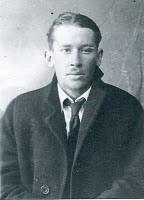 March of 1918, Cummings arrived in New York City. The Thayers had settled into two separate residences on Washington Square. Scofield Thayer, now part-owner and soon to be publisher of the literary journal The Dial, became Cummings's patron, purchasing his paintings and championing his poetry. Thayer's stated reason for living apart from his wife was so he could concentrate on his work. Cummings knew from Elaine, however, that Thayer had lost interest in her, and at first set out to comfort her, but soon he and Elaine were lovers. When Thayer found out his best friend and his wife were having an affair, he was unperturbed. Cummings was then drafted into the infantry that November, just four months before the war ended.
March of 1918, Cummings arrived in New York City. The Thayers had settled into two separate residences on Washington Square. Scofield Thayer, now part-owner and soon to be publisher of the literary journal The Dial, became Cummings's patron, purchasing his paintings and championing his poetry. Thayer's stated reason for living apart from his wife was so he could concentrate on his work. Cummings knew from Elaine, however, that Thayer had lost interest in her, and at first set out to comfort her, but soon he and Elaine were lovers. When Thayer found out his best friend and his wife were having an affair, he was unperturbed. Cummings was then drafted into the infantry that November, just four months before the war ended.By February 1919 Cummings was back in New York, and resumed his affair with Elaine. Then in May--and here's the important part for our purposes here--Elaine announced she was pregnant with Cummings's child. Cummings, frankly, acted terribly. He dropped Elaine and was relieved when his friend Thayer accepted paternity even though everyone knew the truth. Elaine, who was no saint as you will see, was twice abandoned--first by her husband, then by the father of her child.
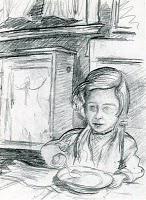 Cummings showed little reaction to the December 20, 1919 birth of his daughter Nancy Thayer. His work was always more important. It wasn't until October 1920 that Cummings had any involvement with his daughter. Thayer and Elaine were planning to divorce, and so Cummings and Elaine renewed their relationship. They saw each other on a daily basis, which meant time with daughter Nancy, who he called Mopsy. By summer of 1921, the little family was living in Paris, although at separate establishments. Elaine led a wealthy life, and the poor Cummings refused to live off of her or Thayer's money. Still, he began to play with Nancy (see his sketch of her to the left), taking her on walks and to the park. His relationship with Elaine grew ever closer, even though they continued to live and travel separately. And he told Nancy stories.
Cummings showed little reaction to the December 20, 1919 birth of his daughter Nancy Thayer. His work was always more important. It wasn't until October 1920 that Cummings had any involvement with his daughter. Thayer and Elaine were planning to divorce, and so Cummings and Elaine renewed their relationship. They saw each other on a daily basis, which meant time with daughter Nancy, who he called Mopsy. By summer of 1921, the little family was living in Paris, although at separate establishments. Elaine led a wealthy life, and the poor Cummings refused to live off of her or Thayer's money. Still, he began to play with Nancy (see his sketch of her to the left), taking her on walks and to the park. His relationship with Elaine grew ever closer, even though they continued to live and travel separately. And he told Nancy stories."THESE TALES WERE WRITTEN for Cummings' daughter, Nancy, when she was a very little girl." So opens the 1965 posthumous publication of four stories entitled simply Fairy Tales. Whether these stories qualify as fairy tales is debatable. They are more like fables or parables.
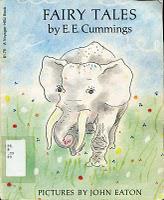 The first is "The Old Man Who Said 'Why'." Anyone with a pre-schooler knows where the inspiration for this story comes from. There was once a fairy who lived on a distant star and was so good-natured that all of the people on the stars would go to him to solve their problems. "Well,after this faerie had lived happily and quietly for millions and millions of years,he woke up one morning on the farthest star and heard a murmuring all around him in the air,and this murmuring seemed to come from all the other stars." All of the people of the stars were on their way to see the fairy with the same problem, "'It's the man who says 'why'!'" He is an old man, he lives on the moon, and all he says is why. The fairy goes to have a talk with the old man, who he finds sitting on a steeple. "'What are you doing up here anyway?' ...'Why?' 'Because I've come all the way from the farthest star to see you,' the faerie said. 'Why?'" The conversation goes on like that. With each question, the very very very very very old man, loses a very, growing younger and younger. Eventually the fairy lays down the ultimatum, if the man says 'why" one more time he'll fall to earth. The old man says 'why' and falls "until,just as he gently touched the earth,he was about to be born."
The first is "The Old Man Who Said 'Why'." Anyone with a pre-schooler knows where the inspiration for this story comes from. There was once a fairy who lived on a distant star and was so good-natured that all of the people on the stars would go to him to solve their problems. "Well,after this faerie had lived happily and quietly for millions and millions of years,he woke up one morning on the farthest star and heard a murmuring all around him in the air,and this murmuring seemed to come from all the other stars." All of the people of the stars were on their way to see the fairy with the same problem, "'It's the man who says 'why'!'" He is an old man, he lives on the moon, and all he says is why. The fairy goes to have a talk with the old man, who he finds sitting on a steeple. "'What are you doing up here anyway?' ...'Why?' 'Because I've come all the way from the farthest star to see you,' the faerie said. 'Why?'" The conversation goes on like that. With each question, the very very very very very old man, loses a very, growing younger and younger. Eventually the fairy lays down the ultimatum, if the man says 'why" one more time he'll fall to earth. The old man says 'why' and falls "until,just as he gently touched the earth,he was about to be born." The second story is "The Elephant & The Butterfly." "Once upon a time there was an elephant who did nothing all day." He lives in a small house at the top of a hill, down which there is a long winding road that leads to another small house "in which a butterfly lived." One day the elephant is sitting at home when he sees a figure making its way up the hill towards his house. It is the butterfly, who stands at the door and asks if anyone is home. He asks three times before the elephant answers and lets him in. It rains while the elephant and butterfly are safe inside, and when the rain stops "the elephant put his arm very gently around the little butterfly and said: 'Do you love me a little?'...And the butterfly smiled and said: 'No, I love you very much.'" They decide to go on a walk, and walk down the long winding path to the butterfly's house. When they get there, "the butterfly said: 'Why didn't you ever before come down into the valley where I live?' And the elephant answered, 'Because I did nothing all day. But now that I know where you live,I'm coming down the curling road to see you every day, if I may--and may I come?' Then the butterfly kissed the elephant and said: 'I love you,so please do.'" The elephant keeps his promise, "And they loved each other always."
The second story is "The Elephant & The Butterfly." "Once upon a time there was an elephant who did nothing all day." He lives in a small house at the top of a hill, down which there is a long winding road that leads to another small house "in which a butterfly lived." One day the elephant is sitting at home when he sees a figure making its way up the hill towards his house. It is the butterfly, who stands at the door and asks if anyone is home. He asks three times before the elephant answers and lets him in. It rains while the elephant and butterfly are safe inside, and when the rain stops "the elephant put his arm very gently around the little butterfly and said: 'Do you love me a little?'...And the butterfly smiled and said: 'No, I love you very much.'" They decide to go on a walk, and walk down the long winding path to the butterfly's house. When they get there, "the butterfly said: 'Why didn't you ever before come down into the valley where I live?' And the elephant answered, 'Because I did nothing all day. But now that I know where you live,I'm coming down the curling road to see you every day, if I may--and may I come?' Then the butterfly kissed the elephant and said: 'I love you,so please do.'" The elephant keeps his promise, "And they loved each other always."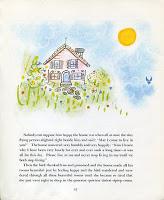 The third story is "The House That Ate Mosquito Pie." Reminiscent of Virginia Lee Burton's masterpiece The Little House, Cummings house is forgotten, abandoned, and lonely. No one will live in him or play in him. "There was the afternoon,of course;but the afternoon rarely came near the house because the afternoon was too busy putting the moon to bed. And there was the night,too;but the night was fondest of wandering and wandering among all the bright and gentle kinds of flowers which you and I call 'stars' because we don't know what they really may be." One day the house hears beautiful singing. He loves the singing and has a sense it is meant for him. A small flying person appears. It is a bird. "Nobody can suppose how happy the house was when all at once the tiny flying person alighted right beside him and said: 'May I come to live in you?'" The house knows at last why he has been lonely and gives an emphatic yes. He sets about cleaning himself up, winding his clocks and washing his windows. And the bird sings. They decide to celebrate over a mosquito pie, but when the bird leaves, she finds there are people who are coming to try to live in the house. Once the people come in to look around, all of the clocks go off "with such a banging and a crashing as you never heard." The people are frightened away. The bird and house make their celebratory mosquito pie. "Not only that--but no people ever bothered them any more,and so they were as happy together as happy could be."
The third story is "The House That Ate Mosquito Pie." Reminiscent of Virginia Lee Burton's masterpiece The Little House, Cummings house is forgotten, abandoned, and lonely. No one will live in him or play in him. "There was the afternoon,of course;but the afternoon rarely came near the house because the afternoon was too busy putting the moon to bed. And there was the night,too;but the night was fondest of wandering and wandering among all the bright and gentle kinds of flowers which you and I call 'stars' because we don't know what they really may be." One day the house hears beautiful singing. He loves the singing and has a sense it is meant for him. A small flying person appears. It is a bird. "Nobody can suppose how happy the house was when all at once the tiny flying person alighted right beside him and said: 'May I come to live in you?'" The house knows at last why he has been lonely and gives an emphatic yes. He sets about cleaning himself up, winding his clocks and washing his windows. And the bird sings. They decide to celebrate over a mosquito pie, but when the bird leaves, she finds there are people who are coming to try to live in the house. Once the people come in to look around, all of the clocks go off "with such a banging and a crashing as you never heard." The people are frightened away. The bird and house make their celebratory mosquito pie. "Not only that--but no people ever bothered them any more,and so they were as happy together as happy could be."The real treasure of the collection is the final story, 'The Little Girl Named I.' It's playful both in form and in content, the most Cummings of the tales, and it offers the best glimpse of the kind of father Cummings could be if he wished. There are two voices, the storyteller and the listener, denoted by indents (the storyteller indented, the listener not). The main character's name is I, so when the storyteller speaks, even though I is a little girl, it is as if Cummings were the main character. For example, "By and by I was walking and walking when whoever do you suppose I should find,sleeping in the sun and fast asleep." (The only other time I've seen this technique is in the excellent Stephen Dixon novels I. and End of I.) Cummings's tale begins:
" Once upon a time there was a little girl named I.
She was a very good little girl,wasn't she?
Yes indeed;very good. So one day this little girl named I was walking all by herself in a green green field. And who do you suppose she meets?
A cow,I suppose."
 Much like the animals in "Henny Penny," the little girl named I goes along and she goes along and she meets different animals. After the yellow cow, there's a white horse, a pink pig, and an elephant. She asks each of them to join her for tea, and for one reason or another none of them do.The elephant gets the largest part in the story. He is eating bananas out of a tree, and he offers I one. She says no, and asks if he would like to go to tea. He says, "'Yes,I'd like to come to tea very much.'"
Much like the animals in "Henny Penny," the little girl named I goes along and she goes along and she meets different animals. After the yellow cow, there's a white horse, a pink pig, and an elephant. She asks each of them to join her for tea, and for one reason or another none of them do.The elephant gets the largest part in the story. He is eating bananas out of a tree, and he offers I one. She says no, and asks if he would like to go to tea. He says, "'Yes,I'd like to come to tea very much.'""Then he came to tea?The next person I meets is another little girl named You. "'You. That's who I am' she said 'And You is my name because I'm You.'" They sit down to tea and jam and bread together. "And that's the end of this story."
No. He didn't.
How was that? I thought he said he'd like to come.
He did. But then he said 'I think I'd better eat these banans that are growing up here,because if I should stop,they'd grow faster than I can eat them.'
That was a very good answer.
Yes. It was. So this little girl named I said to this elephant 'Are you joking with me,shame on you?' and he said 'Yes,I am joking with you,shame on me.' So then she made kewpie eyes for him and he made kewpie eyes for her and then away goes I through the green green field,all by herself."
CUMMINGS AND ELAINE THAYER traveled together and separately in Europe until the end of 1923. Elaine and Nancy returned to New York in September, and Cummings followed just after New Year's. Then he made a surprising decision: to marry Elaine. The couple were married on March 19, 1924. It was Cumming's first marriage, Elaine's (now Elaine Cummings) second.
The main reason for the marriage was Cummings's desire to adopt Nancy so she would be his legal child. He was still passionate about Elaine, but he did not allow marriage to alter his way of life, technically living with Elaine and Nancy, but spending more time at his studio and expecting complete freedom with little responsibility. Two weeks after the wedding, Elaine's younger sister died and Elaine made preparations to return to Europe with Nancy to see after her sister's affairs. On April 25, 1924, Nancy became Cummings's legal daughter (with legal expenses payed by Scofield Thayer), and then she and Elaine returned to Paris by early May. Nancy was not made aware of the new parental arrangement.
Mid-June. A little over six years since the start of their off-again, on-again relationship, but only three months into their marriage, Elaine wrote home that she had met another man on the boat to Europe, Frank MacDermot, that she had fallen in love, and that she wanted a divorce. Cummings was devastated. He considered suicide, he considered murdering MacDermot, he fought and fought. He didn't realize that he had made no effort to actually take part in Elaine's life or have responsibility in it, and that that was the main cause of the end of their relationship, more than a rival. In the end, he realized he must grant her the divorce and that he must not kill himself, for Nancy's sake.
However, Cummings did not bring his paternity into the court proceedings of his divorce. It was only after the fact that he wrangled an agreement out of Elaine (now Elaine MacDermot, her third marriage) to unlimited visitation and custody for three months of the year. However MacDermot immediately blocked Cummings from actually seeing his daughter.
The custody battle was long. Cummings saw his daughter only four more times, the last on March 4, 1927. It was not until she was an adult that they would meet again. She grew up believing that Scofield Thayer was her father.
(INTERLUDE:
May 1929, Cummings married Anne Barton, second marriage for both.
By 1934, Cummings was introducing Marion Morehouse as his wife, although they never legally married, his third "marriage," her first.
1943, Nancy married Theodore Roosevelt's grandson Willard, first marriage for both.
1954, Nancy married Greek classicist Kevin Andrews, her second marriage, his first.
Summer 1968, Nancy and Andrews separate.)
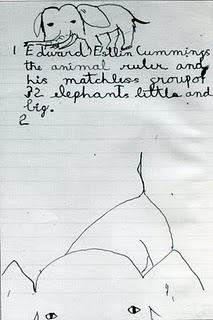 CUMMINGS'S FAIRY TALES with illustrations by John Eaton was published in 1965, three years after Cummings's death. The copyright reads "1950, 1965 Marion Morehouse Cummings," his final wife. It is unclear where these texts came from and why there is a 1950 copyright at all. There is one reference in a letter to Nancy quoted by Cummings biographer Richard S. Kennedy that suggests he sent her at least two fairy tales that he had written for her as a child in order to be read to her children (his grandchildren). It is possible that the 1950 copyright comes from that time, although the exchange would have happened in the 1940s, not 1950. Regardless, it seems most likely that the texts published as Fairy Tales were ones furnished to Nancy in adulthood. It is hard to know whether that means they were written at that later date or that he had them on file since she was a child.
CUMMINGS'S FAIRY TALES with illustrations by John Eaton was published in 1965, three years after Cummings's death. The copyright reads "1950, 1965 Marion Morehouse Cummings," his final wife. It is unclear where these texts came from and why there is a 1950 copyright at all. There is one reference in a letter to Nancy quoted by Cummings biographer Richard S. Kennedy that suggests he sent her at least two fairy tales that he had written for her as a child in order to be read to her children (his grandchildren). It is possible that the 1950 copyright comes from that time, although the exchange would have happened in the 1940s, not 1950. Regardless, it seems most likely that the texts published as Fairy Tales were ones furnished to Nancy in adulthood. It is hard to know whether that means they were written at that later date or that he had them on file since she was a child.Why would that matter?
If the four stories are read as a letter to his adult daughter, then they deliver a very clear narrative. The first story is that of a birth. A very old fairy approaches a much younger (but old) man, and enacts his birth. This can be read as Cummings fathering Nancy. Since Cummings had almost no interaction with Nancy until she was one, it makes sense that his first real experience of her would be of a child who was already asking the question "why?" The other key element of the story is that of a vast physical distance getting traversed for the two beings to come into contact with one another, a theme throughout the rest of the book and Nancy's life.
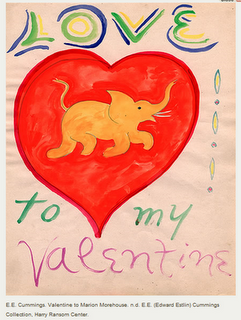
To fully understand the next story in the narrative, it is important to know that Cummings considered the elephant his totem. As a child he was a fan of animal stories, particularly those of Rudyard Kipling, and he came to associate the elephant with his father who carried him about and had big ears. At some point the role reversed and Cummings saw himself as the elephant. He drew elephants repeatedly in his youth (the drawing above is from one of his six-year-old sketchbooks), and throughout his life would sign personal letters with an elephant sketch (the Valentine to the right is to his third wife Marion).
So in "The Elephant & The Butterfly," it is not just that the elephant, a large creature who is separated from a smaller creature, the butterfly, meets that butterfly, but it is Cummings himself who meets Nancy. Initially, the elephant is reluctant to announce his presence, but once he does they immediately profess undying love to one another. When the butterfly asks why the elephant has not come to her house before, he promises her that, now that he knows where it is, he will come to her house every day. So Cummings admits his initial reluctance to being a father, but then swears allegiance to his daughter.
The next story, "The House That Ate Mosquito Pie," is a reprise of the last with one key difference. Again a large being, the house (i.e. Cummings), meets a small flying being, the bird (i.e. Nancy). The bird wants to live in the house and they too declare their love for one another. But their new relationship is threatened by other people who would come between them (to live in the house), just as Elaine and MacDermot separated the father and daughter. In the wish fulfilling story, however, the people are scared away "and no people ever bothered them any more."
Then "The Little Girl Named I." I is Nancy, searching for a companion. She finds the elephant, Cummings, and invites him to tea. But in this story he says, "no." He no longer will be there for her, and in the end the only playmate she finds is herself. It is a sad story, but it reflects how Cummings handled the loss of his daughter, how he was forced to shut her out of his heart so the pain of her loss could not affect him. But it is also a parent saying to his child that at some point you must go out on your own.
 "THE OLD MAN WHO SAID 'WHY'" did appear in print in Cummings's lifetime. In 1945, Nancy's mother-in-law Belle Roosevelt rented a farm house in New Hampshire not far from Cumming's own farm and summer residence. The Cummings and Roosevelts met, although Cummings missed meeting Nancy, as she returned to New York to have a baby. Upon learning that he was a grandfather, Cummings wrote a short play Santa Claus: A Morality Play in which a young girl is reunited with her father who reconciles with her mother, i.e. the dream that Cummings, Elaine, and Nancy could be a family again. The play was published in the Harvard Wake coupled with a poem, and "The Old Man Who Said 'Why.'" Joining the play with the story highlights how deeply Cummings was affected by his daughter's proximity.
"THE OLD MAN WHO SAID 'WHY'" did appear in print in Cummings's lifetime. In 1945, Nancy's mother-in-law Belle Roosevelt rented a farm house in New Hampshire not far from Cumming's own farm and summer residence. The Cummings and Roosevelts met, although Cummings missed meeting Nancy, as she returned to New York to have a baby. Upon learning that he was a grandfather, Cummings wrote a short play Santa Claus: A Morality Play in which a young girl is reunited with her father who reconciles with her mother, i.e. the dream that Cummings, Elaine, and Nancy could be a family again. The play was published in the Harvard Wake coupled with a poem, and "The Old Man Who Said 'Why.'" Joining the play with the story highlights how deeply Cummings was affected by his daughter's proximity.Nancy and Cummings did meet at last, and he had her sit for several portraits. On the day of the last sitting, Cummings's wife Marion left the room, and in that moment Cummings revealed that he was Nancy's father. When Marion returned to the room, she could tell something important had been said. Cummings said to her, "We know who we are."
Marion was fiercely jealous of anyone else in Cummings life, especially his daughter, and she did everything she could to keep Cummings and Nancy apart. In childhood it had been Elaine separating the father and child, now it was the stepmother doing the same. Cummings and Nancy did maintain a relationship, and Cummings, who had shut out his love in order to protect himself, felt a renewed passion for his daughter. But he was never good at showing it, and the relationship was warm but distant.
A NEW EDITION OF CUMMINGS'S, fairy tales re-illustrated by Meilo So, was printed in 2004 and is still in print. The vast majority of Cummings's biography (and several of the images) was cribbed from E. E. Cummings: a biography by Christopher Sawyer-Lauçanno. I also consulted E. E. Cummings: a poet's life by Catherine Reef. (That's where I got Cummings's sketch of Nancy from.) The information on the elephant as Cummings's totem was taken from Dreams in the Mirror: A Biography of E. E. Cummings by Richard S. Kennedy. The entire Cummings/Nancy story is told much better in the essay "A Memorial: Nancy T. Andrews, daughter of E. E. Cummings" by Michael Webster, the full text of which is online.
All images are copyrighted © and owned by their respective holders.

